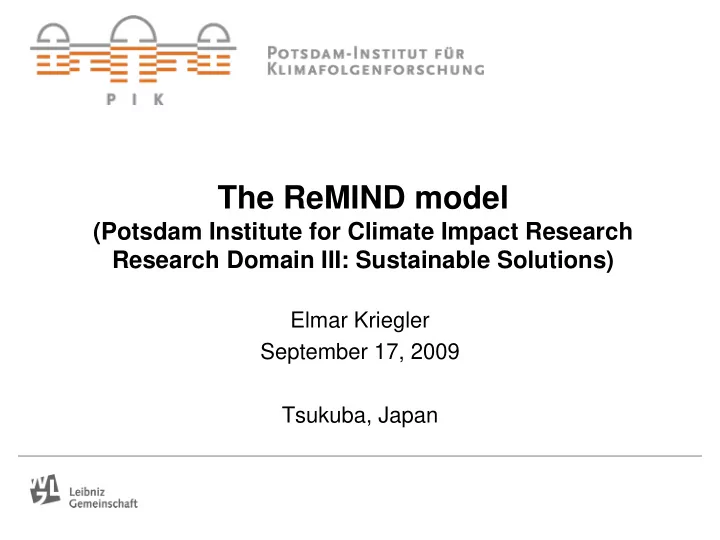

The ReMIND model (Potsdam Institute for Climate Impact Research Research Domain III: Sustainable Solutions) Elmar Kriegler September 17, 2009 Tsukuba, Japan
Key Design Characteristics Participating Model: ReMIND (Refined Model of Investment and Technological Development) Model Type: Ramsey-type macro-economic growth model coupled to energy system model, climate box model, (agro-economic land use model MAgPIE ) Participating Modelers: Marian Leimbach, Nico Bauer, Gunnar Luderer, Lavinia Baumstark, Markus Haller, Michael Lüken, Robert Pietzcker, David Klein, Sylvie Ludig Time Step: 5 years Time Frame: 2005 to 2150 Solution Type: Intertemporal Optimization Equilibrium Type: Intertemporal equilibrium of capital, energy, goods markets Underlying Computing Framework: GAMS Elmar Kriegler Potsdam Institute for Climate Impact Research 2
Inputs and Outputs Key inputs • Demographics: Population by region • Economic: Labour & energy productivity • Resources: Depletable resources by marginal extraction cost curves (after Rogner; coal, oil, gas, uranium); Renewable resources by grade (wind on & off-shore, solar, geothermal, hydro). • Emissions / forcing: CO, NOx, VOC, halocarbons, SF6, OC, BC • Technology: see sketch. CCS for coal, gas, biomass-fired power plants, coal & biomass to liquid technologies, H2 production Key outputs • Economic: GDP, Consumption, Investment, Shadow prices, Mitigation costs, Trade flows • Energy: see sketch • Agriculture (via MAgPIE): Land use pattern, Production costs, Shadow prices Investment in productivity improvements • Emissions: CO 2 (by source), CH 4 , N 2 O, SO 2 Elmar Kriegler • Climate: GHG Concentrations, Radiative Forcing, Temperature, (Ocean pH, Sea level rise) Potsdam Institute for Climate Impact Research 3
Regional Scope & Other Detail Regional Details: • Regional Scope: Global • Number of Sub-Regions: 11 world regions • Asian Regions: China, India, Japan, Other Asia (basically SE Asia, Mongolia, Korea), (Middle East & North Africa), (Russia) Other Details: – Endogenous baseline – Trade in fossil fuels, emission permits, industrial good – Iterative Negishi approach calculating intertemporal market equilibrium 1 st best: full when & where flexibility – 2 nd best: limited participation (regions – & sectors), investment, technology Elmar Kriegler Potsdam Institute for Climate Impact Research 4
Asian Baselines CHN JAP IND OAS Elmar Kriegler Source: RECIPE project Potsdam Institute for Climate Impact Research 5
Previous Work on Asia: Kaya Decomposition Baseline 450 ppm China India Elmar Kriegler Source: RECIPE project Potsdam Institute for Climate Impact Research 6
Regional Distribution of Mitigation Costs Mitigation costs for reaching the 2 o C target (Climate sensitivity 2.8 o C) Allocation rules Contraction & Convergence Equal per capita Intensity Default Source: Lüken, IEW 2009 Elmar Kriegler Potsdam Institute for Climate Impact Research 7
Project China Economics of Climate Change Coordinated by Chinese Welfare Impact of Allocation Rules Economists 50 Forum & Stockholm Environment Institute Focused on • Regulatory instruments • Allocation rules • Financing technology diffusion • China’s options in an international regime Results presented at Forum in Beijing, Sep 12 Synthesis report to be presented at EU-China Summit Nov 2009. 2005-2100, discounted at 5% Elmar Kriegler Source: Flachsland et al. 2009 Potsdam Institute for Climate Impact Research 8
Recommend
More recommend